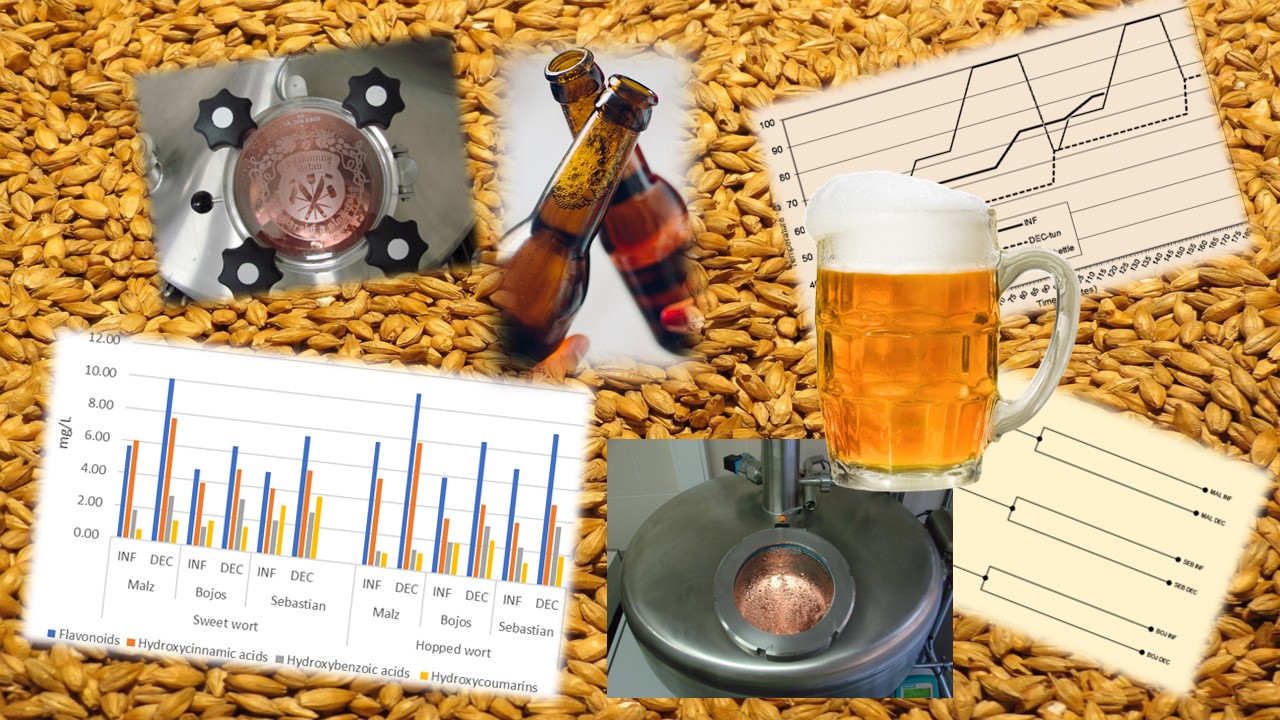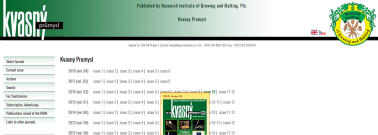Study on the effect of malt and decoction mashing on polyphenols and antiradical power of wort
DOI:
https://doi.org/10.18832/kp2024.70.846Keywords:
mashing, malt, barley variety, polyphenols, free phenolic compounds, antiradical activityAbstract
Mashing is one of the key operations in beer brewing. Together with polyphenolic compounds it can affect the quality and stability of beer. In our pilot brewing trials of pale lager (200 L), malts of three barley varieties were compared using either infusion or double decoction mashing. Total polyphenols, anthocyanogens and flavanoids were determined in sweet and hopped wort. Free phenolics were measured by HPLC coupled with coulometric detection. Antiradical power was determined by RC-DCPI, ARA-DPPH and ESR-T150 methods. In this way the influence of mashing method and barley variety on polyphenols and antiradical activity of sweet wort was demonstrated showing that the effect of mashing was stronger (ANOVA). The results showed significantly higher, i.e. by tens of per cent, levels of all polyphenols studied in both the decoction sweet wort and hopped wort. The decoction process resulted in higher levels of the antiradical power, ARA-DPPH (37–47%) and RC-DCPI (25–60%). A cluster analysis partitioned 28 free phenolic compounds in sweet wort primarily by variety and secondarily by mashing. The Malz malt showed a greater increase in polyphenols, free phenolic compounds and antiradical power in the decoction process compared to the Bojos and Sebastian malts. Decoction mashing introduces higher levels of phenolic antioxidants into the beer with the potential to improve the sensory stability of the beer and provide health benefits to the consumer. The different behaviour of malts and barley varieties needs to be better elucidated in further research.
References
Aron, P.M., Shellhammer, T.H. (2010). A discussion of polyphenols in beer physical and flavour stability. Journal of the Institute of Brewing, 116, 369–380. https://doi.org/10.1002/j.2050-0416.2010.tb00788.x
Basařová, G., Šavel, J., Basař, P., Lejsek, T. (2017). The comprehensive guide to brewing. Fachverlag Hans Carl, Nürenberg. ISBN 978-3418008424
Callemien, D., Bennani, M., Counet, C., Collin, S. (2005) Which polyphenols are involved in aged beer astringency? Assessment by HPLC and time-intensity method. Proceedings of the 30th Congress of the European Brewery Convention, Prague, Fachverlag Hans Carl, Nurnberg, CD-ROM, 809–814.
European Commission (2008) [online]. https://eur-lex.europa.eu/legal-content/CS/TXT/?uri=OJ:C:2008:016:TOC [accessed 2024-01-25].
Szwajgier, D. (2009). Content of individual phenolic acids in worts and beers and their possible contribution to the antiradical activity of beer. Journal of the Institute of Brewing, 115, 243–252. https://doi.org/10.1002/j.2050-0416.2009.tb00376.x
Guido, L.F., Curto, A.F., Boivin, P., Benismail, N., Goncalves, C.R., Barros, A.A. (2007). Correlation of Malt Quality Parameters and Beer Flavor Stability: Multivariate Analysis. Journal of Agricultural and Food Chemistry, 55, 728–733. https://doi.org/10.1021/jf0623079
Holtekjölen, A.K., Kinitz, C., Knutsen, S.H. (2006). Flavanol and bound phenolic acid contents in different barley varieties. Journal of Agricultural and Food Chemistry, 54, 2253–2260. https://doi.org/10.1021/jf052394p
Jurková, M., Horák, T., Hašková, D., Čulík, J., Čejka P., Kellner, V. (2012). Control of antioxidant beer activity by the mashing process. Journal of the Institute of Brewing, 118, 230–235. https://doi.org/10.1002/jib.35
Jurková, M., Kellner, V., Čulík, J., Horák, T., Čejka, P., Karásek, P. (2010). Analysis of polyphenols in brewing raw materials by PSE (Pressurized Solvent Extraction) – and by HPLC method with CoulArray detection. Kvasny prumysl, 56(1), 18–23. https://doi.org/10.18832/kp2010003
Kaneda, H., Kobayashi, N., Furusho, S., Sahara, H., Koshino, S. (1999). Reducing activity and flavor stability of beer. Techechnical Quarterly MBAA, 32, 90–94.
Mareček, V., Mikyška, A., Hampel, D., Čejka, P., Neuwirthová, L., Malachová, A., Cerkal, R. (2017). ABTS and DPPH methods as a tool for studying antioxidant capacity of spring barley and malt. Journal of Cereal Science, 72, 40–45. https://doi.org/10.1016/j.jcs.2016.11.004
MEBAK (2013). Collection of Brewing Analysis Methods of the Mitteleuropäische Brautechnische Analysenkommission. Wort, Beer, Beer-based beverages, Fachverlag Hans Carl, Nürenberg. ISBN 978-3-9805814-7-9
Mertens, T., Kunz, T., Methner, F.-J. (2020). Assessment of chelators in wort and beer model solutions. Brewing Science, 73(5-6), 58–67. https://doi.org/10.23763/BrSc20-01mertens
Mikyška, A., Dušek, M., Čejka, P. (2019). Influence of barley variety and growing locality on the profile of flavonoid polyphenols in malt. Kvasny prumysl, 65(5),149–157. https://doi.org/10.18832/kp2019.65.149
Mikyška, A., Jurková, M. (2019). Varietal specificity of polyphenols, free phenolics and antioxidant potential in hops. Kvasny prumysl, 65(6), 178–185. https://doi.org/10.18832/kp2019.65.178
Mikyška, A., Jurková, M., Horák, T., Slabý, M. (2022). Study of the influence of hop polyphenols on the sensory stability of lager beer. European Food Research Technology, 248, 533–542. https://doi.org/10.1007/s00217-021-03900-0
Mikyška, A., Krofta, K., Hašková, D. (2006). Evaluation of antioxidant properties of hop and hop products. Kvasny prumysl, 52, 214–218. https://doi.org/10.18832/kp2006020
Mikyška, A., Dušek, M., Slabý, M. (2023). Effects of the mashing process on polyphenols and antiradical activity of beer. European Food Research Technology, 249, 71–80. https://doi.org/10.1007/s00217-022-04133-5
Nowak, R., Olech, M., Nowacka, N. (2014). Plant polyphenols as chemopreventive agents. In: Watson, R., Preedy, V., Zibadi, S., (eds.). Polyphenols in human health and disease. Elsevier, San Diego, 1289–1307. https://doi.org/10.1016/B978-0-12-398456-2.00086-4
Pascoe, H.M., Ames, J.M., Sachin, C. (2003). Critical stages of the brewing process for changes in antioxidant activity and levels of phenolic compounds in ale. Journal of the American Society of Brewing Chemists, 61(4), 203–209. https://doi.org/10.1094/ASBCJ-61-0203
Psota, V., Dvořáčková, O., Musilová, M. (2022). Barley varieties registered in the Czech Republic after the harvest of 2021. Kvasny Prumysl, 68(2), 590–601. https://doi.org/ 10.18832/kp2021.68.590
Radonjic, S., Maraš, V., Raičevic, J., Košmerl, T. (2020). Wine or beer? Comparison, changes and improvement of polyphenolic compounds during technological phases. Molecules, 25, 4960. https://doi.org/10.3390/molecules25214960
Steiner, E., Becker, T, Gastl, M. (2010). Turbidity and haze formation in beer - insights and overview. Journal of the Institute of Brewing, 116, 360–368. https://doi.org/10.1002/j.2050-0416.2010.tb00787.x
Ushida, M., Suga, S., Ono, M. (1996). Improvement of oxidative flavor stability of beer - Rapid prediction method for beer flavor stability by electron spin resonance spectroscopy. Journal of the American Society of Brewing Chemists, 54, 205–211. https://doi.org/10.1094/ASBCJ-54-0205
Vanbeneden, N., Van Roey, T., Willems, F., Delvaux, F., Delvaux, F.R. (2008). Release of phenolic flavour precursors during wort production: Influence of process parameters and grist composition on ferulic acid release during brewing. Food Chemistry, 111, 83–91. https://doi.org/10.1016/j.foodchem.2008.03.029
Wannenmacher, J., Cotterchio, C., Schlumberger, M., Reuber, V., Gastl, M., Becker, T. (2019). Technological influence on sensory stability and antioxidant activity of beers measured by ORAC and FRAP. Journal of the Science of Food and Agriculture, 99(14), 6628–6637. https://doi.org/10.1002/jsfa.9979
Wannenmacher, J., Gastl, M., Becker, T. (2018). Phenolic Substances in Beer: Structural Diversity, Reactive Potential and Relevance for Brewing Process and Beer Quality. Comprehensive Reviews in Food Science and Food Safety, 17(4), 953–988. https://doi.org/10.1111/1541-4337.12352
Zavrelová, M., Psota, V., Matusinsky, P., Musilová, M., Némethová, M. (2021). Evaluation of malting quality of spring barley genetic resources from different regions of origin. Kvasny Prumysl, 67(1), 392–402. https://doi.org/10.18832/kp2021.67.392
Zhao, H., Zhao, M. (2012). Effects of mashing on total phenolic contents and antioxidant activities of malts and worts. International Journal of Food Science and Technology, 47, 240–247. https://doi.org/10.1111/j.1365-2621.2011.02831.x

Downloads
Published
How to Cite
Issue
Section
License
Copyright (c) 2024 Alexandr Mikyška, Marie Jurková

This work is licensed under a Creative Commons Attribution 4.0 International License.







